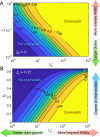Stochastic dynamics of barrier island elevation
- PMID: 33443196
- PMCID: PMC7817221
- DOI: 10.1073/pnas.2013349118
Stochastic dynamics of barrier island elevation
Abstract
Barrier islands are ubiquitous coastal features that create low-energy environments where salt marshes, oyster reefs, and mangroves can develop and survive external stresses. Barrier systems also protect interior coastal communities from storm surges and wave-driven erosion. These functions depend on the existence of a slowly migrating, vertically stable barrier, a condition tied to the frequency of storm-driven overwashes and thus barrier elevation during the storm impact. The balance between erosional and accretional processes behind barrier dynamics is stochastic in nature and cannot be properly understood with traditional continuous models. Here we develop a master equation describing the stochastic dynamics of the probability density function (PDF) of barrier elevation at a point. The dynamics are controlled by two dimensionless numbers relating the average intensity and frequency of high-water events (HWEs) to the maximum dune height and dune formation time, which are in turn a function of the rate of sea level rise, sand availability, and stress of the plant ecosystem anchoring dune formation. Depending on the control parameters, the transient solution converges toward a high-elevation barrier, a low-elevation barrier, or a mixed, bimodal, state. We find the average after-storm recovery time-a relaxation time characterizing barrier's resiliency to storm impacts-changes rapidly with the control parameters, suggesting a tipping point in barrier response to external drivers. We finally derive explicit expressions for the overwash probability and average overwash frequency and transport rate characterizing the landward migration of barriers.
Keywords: Barrier islands; coastal dunes; master equation; stochastic dynamics.
Conflict of interest statement
The authors declare no competing interest.
Figures




References
-
- Durán Vinent O., Moore L. J., Barrier island bistability induced by biophysical interactions. Nat. Clim. Change 5, 158–162 (2015).
-
- Rodriguez-Iturbe I., Porporato A., Ridolfi L., Isham V., Coxi D. R., Probabilistic modelling of water balance at a point: The role of climate, soil and vegetation. Proc. R. Soc. A. Math. Phys. Eng. Sci. 455, 3789–3805 (1999).
-
- Moore L. J., Vinent O. D., Ruggiero P., Vegetation control allows autocyclic formation of multiple dunes on prograding coasts. Geology 44, 559–562 (2016).
Publication types
LinkOut - more resources
Full Text Sources

